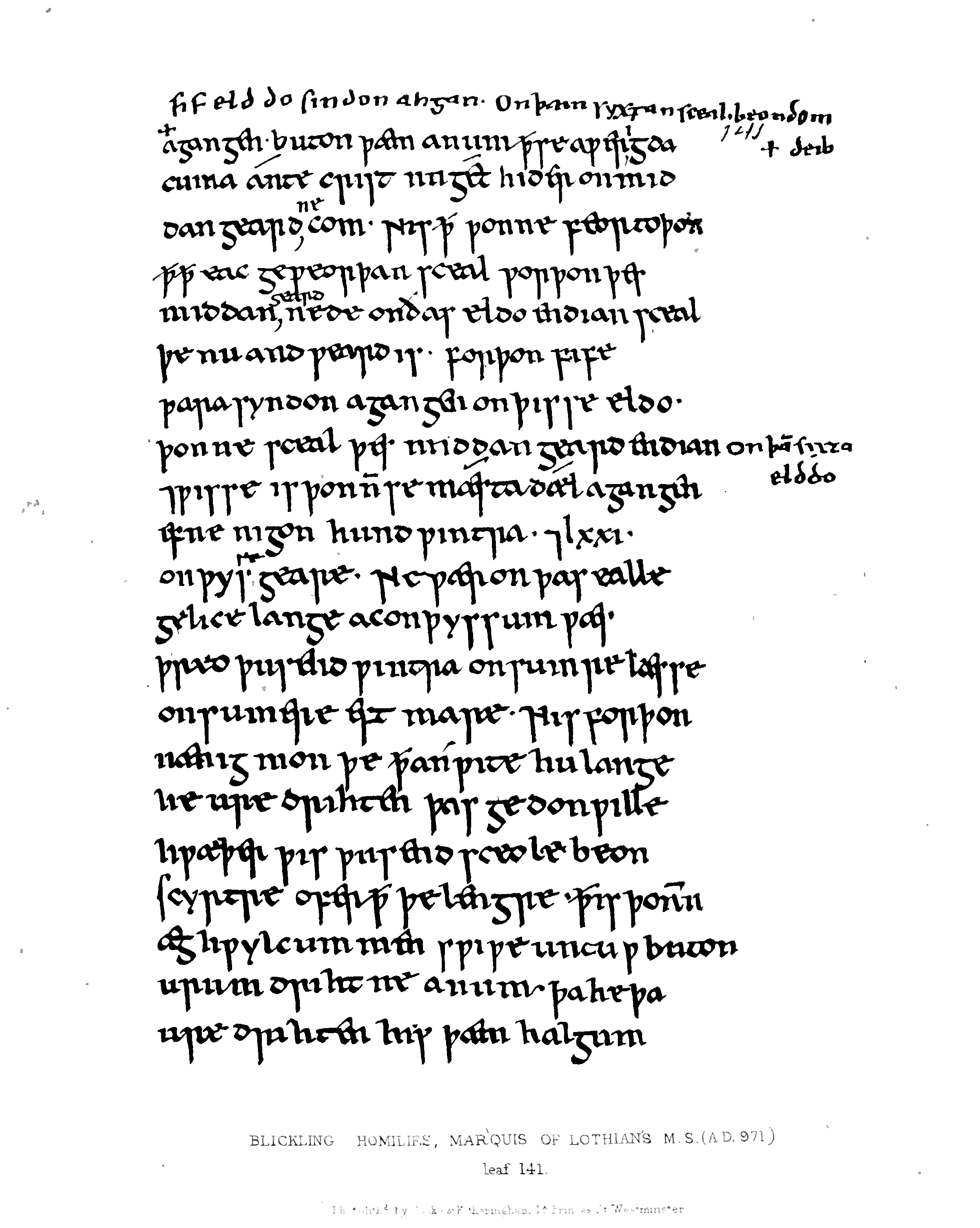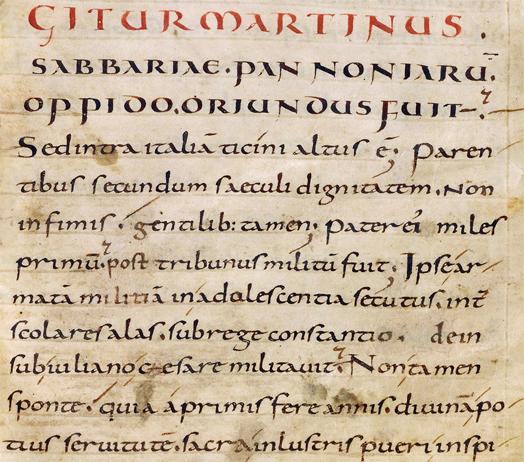|
Katherine Group
The so-called ''Katherine Group'' is a group of five 13th century Middle English texts composed by an anonymous author of the English West Midlands, in a variety of Middle English known as AB language. The texts are all addressed to anchoresses (religious recluses) and praise the virtue of virginity. The texts * The sermon ''Hali Meiðhad'' ("holy maidenhood"), directed at anchoresses or recluses, praising the virtues of virginity over worldly marriage. It was written in ca. 1182–1198 in the West Midlands of England. * The allegory '' Sawles Warde'' ("refuge of the souls") * ''Seinte Juliene'', life of Juliana of Nicomedia * ''Seinte Margarete'', life of Margaret of Antioch * ''Seinte Katherine'', life of Catherine of Alexandria. All five texts are preserved in the manuscript Oxford, Bodleian Library, Bodley 34. All except ''Hali Meiðhad'' are also in British Library, Royal 17 A XXVII. Additionally, British Library Cotton Titus D XVIII has ''Sawles Warde'', ''Seinte Kat ... [...More Info...] [...Related Items...] OR: [Wikipedia] [Google] [Baidu] |
Middle English
Middle English (abbreviated to ME) is a form of the English language that was spoken after the Norman conquest of 1066, until the late 15th century. The English language underwent distinct variations and developments following the Old English period. Scholarly opinion varies, but the '' Oxford English Dictionary'' specifies the period when Middle English was spoken as being from 1150 to 1500. This stage of the development of the English language roughly followed the High to the Late Middle Ages. Middle English saw significant changes to its vocabulary, grammar, pronunciation, and orthography. Writing conventions during the Middle English period varied widely. Examples of writing from this period that have survived show extensive regional variation. The more standardized Old English language became fragmented, localized, and was, for the most part, being improvised. By the end of the period (about 1470) and aided by the invention of the printing press by Johannes Gutenberg in ... [...More Info...] [...Related Items...] OR: [Wikipedia] [Google] [Baidu] |
Early English Text Society
The Early English Text Society (EETS) is a text publication society founded in 1864 which is dedicated to the editing and publication of early English texts, especially those only available in manuscript. Most of its volumes contain editions of Middle English or Old English texts. It is known for being the first to print many important English manuscripts, including Cotton Nero A.x, which contains ''Pearl'', '' Sir Gawain and the Green Knight'', and other poems. History The Society was founded in England in 1864 by Frederick James Furnivall. Its stated goal was "on the one hand, to print all that is most valuable of the yet unprinted in English, and, on the other, to re-edit and reprint all that is most valuable in printed English books, which from their scarcity or price are not within the reach of the student of moderate means." As of 2020, the Society had published 354 volumes in its Original Series; 126 volumes in its Extra Series, published between 1867 and 1935, comp ... [...More Info...] [...Related Items...] OR: [Wikipedia] [Google] [Baidu] |
Cotton Library
The Cotton or Cottonian library is a collection of manuscripts once owned by Sir Robert Bruce Cotton MP (1571–1631), an antiquarian and bibliophile. It later became the basis of what is now the British Library, which still holds the collection. After the Dissolution of the Monasteries, many priceless and ancient manuscripts that had belonged to the monastic libraries began to be disseminated among various owners, many of whom were unaware of the cultural value of the manuscripts. Cotton's skill lay in finding, purchasing and preserving these ancient documents. The leading scholars of the era, including Francis Bacon, Walter Raleigh, and James Ussher, came to use Sir Robert's library. Richard James acted as his librarian. The library is of special importance for having preserved the only copy of several works, such as happened with ''Beowulf'' and '' Sir Gawain and the Green Knight''. History Origins At the time of the Dissolution of the Monasteries, official state records ... [...More Info...] [...Related Items...] OR: [Wikipedia] [Google] [Baidu] |
Christian Hagiography
A hagiography (; ) is a biography of a saint or an ecclesiastical leader, as well as, by extension, an adulatory and idealized biography of a founder, saint, monk, nun or icon in any of the world's religions. Early Christian hagiographies might consist of a biography or ', a description of the saint's deeds or miracles (from Latin ''vita'', life, which begins the title of most medieval biographies), an account of the saint's martyrdom (called a ), or be a combination of these. Christian hagiographies focus on the lives, and notably the miracles, ascribed to men and women canonized by the Roman Catholic church, the Eastern Orthodox Church, the Oriental Orthodox churches, and the Church of the East. Other religious traditions such as Buddhism, Hinduism, Taoism, Islam, Sikhism and Jainism also create and maintain hagiographical texts (such as the Sikh Janamsakhis) concerning saints, gurus and other individuals believed to be imbued with sacred power. Hagiographic works, especi ... [...More Info...] [...Related Items...] OR: [Wikipedia] [Google] [Baidu] |
Wooing Group
The Wooing Group (or Wohunge Group) is a term coined by W. Meredith Thompson to identify the common provenance of four early Middle English prayers and meditations, written in rhythmical, alliterative prose. The particular variety of Middle English in which the group is written is AB language, a written standard of the West Midlands which also characterises the ''Ancrene Wisse'' and the ''Katherine Group''.Michelle M. Sauer, 'Wooing Group', in ''Encyclopedia of Medieval Literature'' (2013)/ref> The group comprises: * ''Þe Wohunge of ure Laured'' (The Wooing of Our Lord), a meditation 'emphasizing the desirability of Christ as a lover and his sufferings to gain the love of humanity'. (British Library, Cotton MS Titus D XVIII, ff. 127r–133r). * ''On wel swuðe God Ureisun of God Almihti'' (An Exceedingly Good Orison to God Almighty), also a meditation on the same theme. (British Library, Cotton MS Nero A XIV; Lambeth Palace Library, MS 487 ncomplete. * ''On Lofsong of ure Loured'' ... [...More Info...] [...Related Items...] OR: [Wikipedia] [Google] [Baidu] |
Ancrene Wisse
''Ancrene Wisse'' (also known as the ''Ancrene Riwle'' or ''Guide for Anchoresses'') is an anonymous monastic rule (or manual) for female anchoresses written in the early 13th century. The work consists of eight parts: divine service, keeping the heart, moral lessons and examples, temptation, confession, penance, love, and domestic matters. Parts 1 and 8 deal with what is called the "Outer Rule" (relating to the anchoresses' exterior life), while Parts 2–7 deal with the "Inner Rule" (relating to the anchoresses' interior life). Community The adoption of an anchorite life was widespread all over medieval Europe, and was especially popular in England. By the early thirteenth century, the lives of anchorites or anchoresses was considered distinct from that of hermits. The hermit vocation permitted a change of location, whereas the anchorites were bound to one place of enclosure, generally a cell connected to a church. ''Ancrene Wisse'' was originally composed for three sisters who ... [...More Info...] [...Related Items...] OR: [Wikipedia] [Google] [Baidu] |
Ancrene Wisse And Hali Meiðhad
"Ancrene Wisse and Hali Meiðhad" is a 1929 essay by J. R. R. Tolkien on the thirteenth century Middle English treatise '' Ancrene Wisse'' ("The Anchoresses' Rule") and on the tract on virginity ''Hali Meiðhad'' ("Holy Maidenhood"). The essay has been called "the most perfect of Tolkien's academic pieces". Tolkien and Ker later (in 1962) edited a volume of the text for the Early English Text Society The Early English Text Society (EETS) is a text publication society founded in 1864 which is dedicated to the editing and publication of early English texts, especially those only available in manuscript. Most of its volumes contain editions of ....J. R. R. Tolkien, N. R. Ker, eds. (1962) ''The English Text of the Ancrene Riwle (Ancrene Wisse, Corpus Christi College Cambridge MS 402)''. (Early English Text Society; 249). Oxford U. P. References 1929 essays Essays about literature Essays by J. R. R. Tolkien Middle English Works about philology Works about the Middle A ... [...More Info...] [...Related Items...] OR: [Wikipedia] [Google] [Baidu] |
The Devil's Coach Horses
"The Devil's Coach Horses" is a 1925 essay by J. R. R. Tolkien ("devil's coach horse" is the common name of a particular kind of rove beetle). Tolkien draws attention to the devil's steeds called ''eaueres'' in ''Hali Meidhad'', translated "boar" in the Early English Text Society edition of 1922, but in reference to the ''jumenta'' "yoked team, draught horse" of Joel (), in the Vulgata Clementina The Sixto-Clementine Vulgate or Clementine Vulgate () is the edition promulgated in 1592 by Pope Clement VIII of the Vulgate—a 4th-century Latin translation of the Bible that was written largely by Jerome. It was the second edition of t ... ''computruerunt jumenta in stercore suo''http://www.latin-nerds.com/latin-vulgate-bible/Joel.php (the Nova Vulgata has ''semina'' for Hebrew "grain"). Rather than from the Old English word for "boar", ''eofor'' (German ''Eber'') Tolkien derives the word from ''eafor'' "packhorse", from a verb ''aferian'' "transport", related to Mi ... [...More Info...] [...Related Items...] OR: [Wikipedia] [Google] [Baidu] |
Cotton Titus
This is an incomplete list of some of the manuscripts from the Cotton library that today form the Cotton collection of the British Library. Some manuscripts were destroyed or damaged in a fire at Ashburnham House in 1731, and a few are kept in other libraries and collections. Robert Bruce Cotton organized his library in a room long by six feet wide filled with bookpresses, each with the bust of a figure from classical antiquity on top. Counterclockwise, these were Julius Caesar, Augustus, Cleopatra, Faustina, Tiberius, Caligula, Claudius, Nero, Galba, Otho, Vitellius, Vespasian, Titus, and Domitian. (Domitian had only one shelf, perhaps because it was over the door). In each press, each shelf was assigned a letter; manuscripts were identified by the bust over the press, the shelf letter, and the position of the manuscript (in Roman numerals) counting from the left side of the shelf. Thus, the Lindisfarne Gospels, Nero B.iv, was the fourth manuscript from the left on the sec ... [...More Info...] [...Related Items...] OR: [Wikipedia] [Google] [Baidu] |
West Midlands (region)
The West Midlands is one of nine official regions of England at the first level of International Territorial Level for statistical purposes. It covers the western half of the area traditionally known as the Midlands. The region consists of the counties of Herefordshire, Shropshire, Staffordshire, Warwickshire, West Midlands and Worcestershire. The region has seven cities; Birmingham, Coventry, Hereford, Lichfield, Stoke-on-Trent, Wolverhampton and Worcester. The West Midlands region is geographically diverse, from the urban central areas of the West Midlands conurbation to the rural counties of Herefordshire, Shropshire and Worcestershire which border Wales. The region is landlocked. However, the longest river in the UK, the River Severn, traverses the region southeastwards, flowing through the county towns of Shrewsbury and Worcester, and the Ironbridge Gorge, a UNESCO World Heritage Site. Staffordshire is home to the industrialised Potteries conurbati ... [...More Info...] [...Related Items...] OR: [Wikipedia] [Google] [Baidu] |
Catherine Of Alexandria
Catherine of Alexandria (also spelled Katherine); grc-gre, ἡ Ἁγία Αἰκατερίνη ἡ Μεγαλομάρτυς ; ar, سانت كاترين; la, Catharina Alexandrina). is, according to tradition, a Christian saint and virgin, who was martyred in the early fourth century at the hands of the emperor Maxentius. According to her hagiography, she was both a princess and a noted scholar who became a Christian around the age of 14, converted hundreds of people to Christianity and was martyred around the age of eighteen. More than 1,100 years after Catherine's martyrdom, Joan of Arc identified her as one of the saints who appeared to and counselled her.Williard Trask, ''Joan of Arc: In Her Own Words'' (Turtle Point Press, 1996), 99 The Eastern Orthodox Church venerates her as a Great Martyr and celebrates her feast day on 24 or 25 November, depending on the regional tradition. In Catholicism, Catherine is traditionally revered as one of the Fourteen Holy Helpers a ... [...More Info...] [...Related Items...] OR: [Wikipedia] [Google] [Baidu] |
Margaret Of Antioch
Margaret, known as Margaret of Antioch in the West, and as Saint Marina the Great Martyr ( grc-gre, Ἁγία Μαρίνα) in the East, is celebrated as a saint on 20 July in the Western Rite Orthodoxy, Roman Catholic Church and Anglicanism, on 17 July (Julian calendar) by the Eastern Orthodox Church and on Epip 23 and Hathor 23 in the Coptic Orthodox Church of Alexandria. She was reputed to have promised very powerful indulgences to those who wrote or read her life, or invoked her intercessions; these no doubt helped the spread of her following. Margaret is one of the Fourteen Holy Helpers, and is one of the saints Joan of Arc claimed to have spoken with. Hagiography According to a 9th-century martyrology of Rabanus Maurus, she suffered at Antioch in Pisidia (in what is now Turkey) in around 304, during the Diocletianic persecution. She was the daughter of a pagan priest named Aedesius. Her mother having died soon after her birth, Margaret was nursed by a Christian woman ... [...More Info...] [...Related Items...] OR: [Wikipedia] [Google] [Baidu] |





